19. Heilig-Geist-Spital
First mentioned in 1309
A chapel and an almshouse were
part of the hospital. The complex
was used as a school from
1836 to 1880.
The hospital, which was first mentioned in 1309, yet possibly was even older, served as accommodation for the poor and sick and was mutually funded by the city and collegiate church. Both were responsible for the administration of donations, bestowals and proceeds from the estate. The hospital was entirely reliant on the charity, endowments and benevolence of individuals or brotherhoods for providing help to the poorest and weakest in society. Following the construction of the new hospital, the facility served as a school from 1836 to 1880. The property has been in private possession since then.
The Gothic building stock can only be recognised in the gable facing the street.
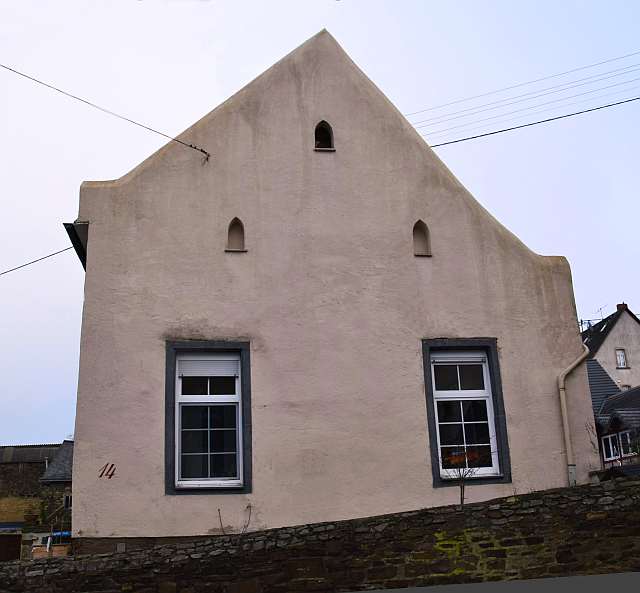
The hospital building, which consisted of the chapel and the adjoining poorhouse, was very much altered in the 19th century. A map from 1826 shows the entire complex in plan.
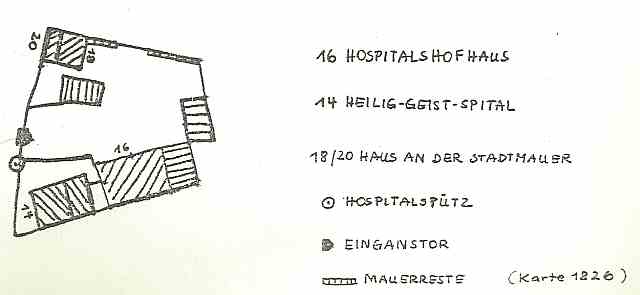
In the photo from around 1900, we see the "Hospitalpütz" surrounded by children.
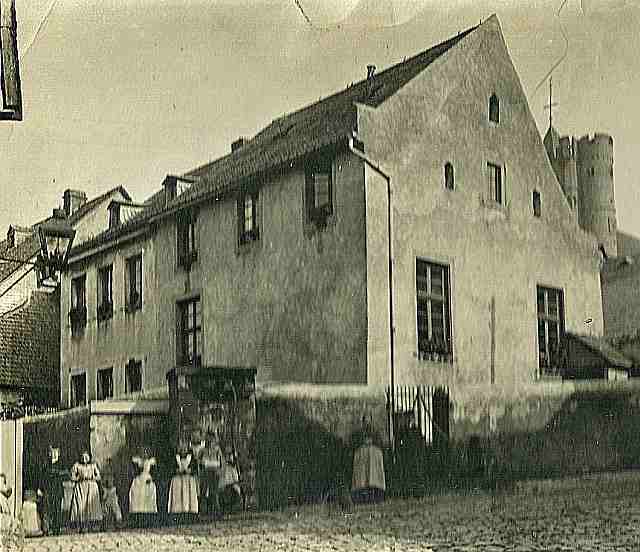
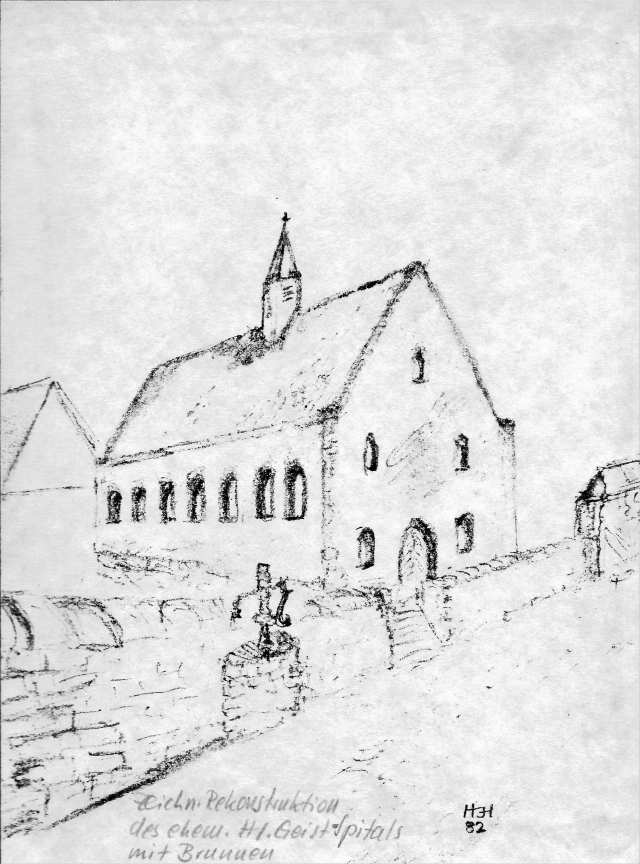
The establishment of a hospital, probably even before it was first mentioned in 1309, was also connected with the development of the monastery. Since the synods of Aachen in 817 and 836, the collegiate foundations were required to maintain a hospital for the sick and the poor.
However, "Holy Spirit hospitals" were usually burghers' hospitals. They were often built near a city gate and a well. Both of these apply to our hospital. In 1309, the town granted the chapel in the "Heilig-Geist-Spital" a donation of two marks of coin and six malters of wheat. From then on, the city and the monastery remained jointly responsible for the hospital. The hospital was administered by two commissioners, one of whom was the dean of the monastery, the other a representative of the town. The hospital was maintained by donations and bequests. It owned estates and farms in Küttig, Rüber, Hatzenport, Burgen and Münstermaifeld. In the 18th century, the building and the administration were in a "miserable" condition. This is stated in the decree of 8 September 1725 issued by the Elector Franz Ludwig for the hospital. The bedrooms were to be cleaned, whitewashed and put into a usable condition. It was also reprimanded that the "poor helpless pious souls" were not being helped sufficiently. Strict care was to be taken that "the dissolute riffraff" were not admitted. The Elector, on the other hand, was satisfied with the condition of the house chapel. Thirty years later, in 1754, the house still housed riffraff, vagabonds and deserters and lacked a second room to accommodate men and women separately.
It was badly damaged by warfare in the aftermath of the French Revolution in 1792/93. The altar and all pictures with a religious reference were removed in 1808. The chapel was used as a lumberyard. From 1791- 1799, Martin Draeger from Trier was the administrator of the hospital courtyard house. Thus, on 9 September 1794, one of the famous "sons of the city" was born here, Anton Joseph Draeger, who, since 1821 in Rome in the circle of the "Nazarenes", developed into one of the most sought-after painters of his time. He died at the age of 38 on 26 July 1833 in Rome. His paintings hang today in museums in Copenhagen, Rome, Dresden, Hanover and Trier.
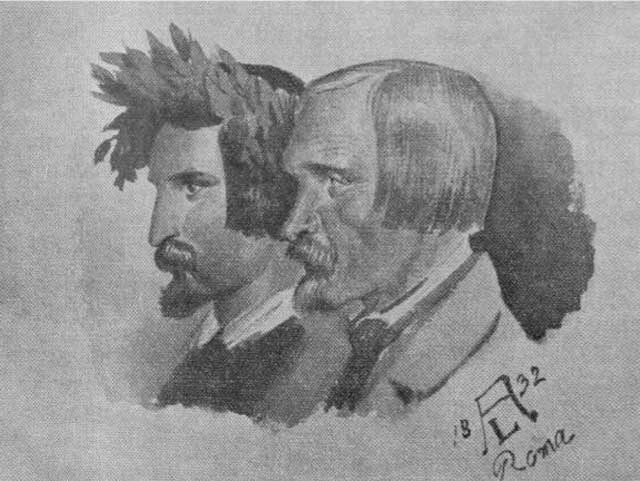
Anton Joseph Draeger (1794-1833), to the right of Friedrich Preller, one year before his death.
After the construction of the new hospital, the Heilig-Geist Spital served as a school and teacher's residence from 1836 to 1880. After that, the property passed into private ownership.
In addition to the hospital, there were a large number of foundations and brotherhoods in the town that provided what we expect from the welfare state today.


Among them, the oldest was the St. Michael's Brotherhood, founded in 1216. It was especially dedicated to the care of the poor. The guilds also had their own brotherhoods, such as the clothiers' Mother of God Brotherhood and the weavers' Mary Brotherhood. The Agatha Brotherhood was closely connected to the tailors' guild. The Sebastianus Brotherhood, documented since 1610, was an urban brotherhood. The Brotherhood of the Fear of Death, founded at the beginning of the 18th century, was dedicated to the care of the dying.
In addition to a number of individual foundations, the proceeds of which were earmarked for feeding the poor, there were the Great and the Small Alms. These were given to widows, orphans, the house poor, pilgrims, the sick and others in need. Both alms were merged with the hospital assets in 1799. The "Holy Spirit Hospital" as well as the brotherhoods and the foundations remind us of the fears and needs of the people at a time when they could only face the threats with solidarity borne out of faith.
Glossary
Collegiate Abbey
The collegiate convent, also known as canonical convent, was a community of secular priests. They did not belong to any religious order. The canons, also called canons, owned private property and did not take vows. They could leave the community at any time. Often the canonate was a purely honorary title or even just a source of income. Recommendations for admission as a canon came from the archbishop, pope or even king.
Dean
He was at the head of the chapter, the assembly of the canons. As a rule, he was elected by the chapter and confirmed by the archbishop. He was primarily responsible for the observance of the rules by the canons and supervised the financial conduct of the monastery. The reprimands for indiscipline were repeated until the 18th century. For example, the canons and vicars found it difficult to adhere to the dress code. The ban on wearing a knife at the belt had to be recalled, as did the renunciation of wearing gloves and nailed shoes. The services in church often lacked the necessary devotion. For example, letters were read during the choir prayer and people talked to each other during the service. An often repeated admonition was



